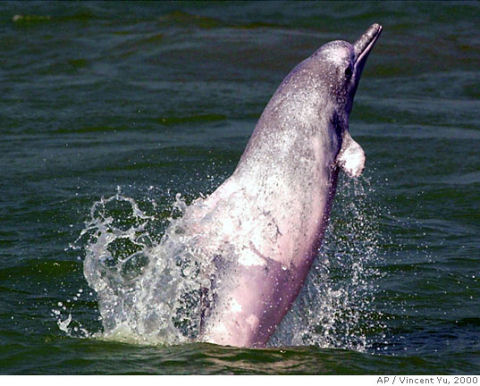
For the first time since the Caribbean monk seal was pushed to extinction in the 1950s, humans have now destroyed yet another aquatic mammal, only this time it’s the first large aquatic animal destroyed directly by human activity: the Yangtze River dolphin in China (a.k.a. the Baiji or Chinese lake dolphin, Lipotes vexillifer). Although there remains the possibility of one or two of the animals having been missed by the latest expedition, the species has now been declared functionally extinct. At least 20 to 25 of the animals would be needed to offer any chance for survival.
The last survey of the white, nearly-blind freshwater dolphins taken in 1997 identified only 13 individuals throughout the entire river system, a significant drop from the more than 400 suspected to have been living there in the 1980s. By 2004, only one sighting was reported by a local fisherman. By early 2006, a plan was implemented to try saving the animals while simultaneously performing a new population census. The search lasted six weeks and drew support and involvement from scientists from six different nations, yet the desperate search yielded no results: not a single dolphin was sighted or heard.
At over 20 million years old, the river dolphin was one of the world’s oldest species. Its extinction is attributed to heavy pollution, illegal fishing, collisions with ships, destruction of the habitat, and sound interference with their sonar (since they had almost no usable eyesight, any sound pollution powerful enough to interfere with their sonar would render them unable to hunt or navigate).
The Chinese people regarded the Baiji as the “goddess of the Yangtze.” Although there was much support for efforts to save the dolphins, even if that meant capturing and moving them to a reserve, disputes between the Chinese government and Western scientists on how best to protect the animals delayed action throughout the 1990s during which the population collapsed. A major aspect of the disagreement involved urgings from scientists and the Western world for China to implement regulations on use of the river. Because such limits on human activity would have interfered with the unbridled economic growth and industrial activities in the country, no such rules were enacted, yet the Chinese government had hoped to bolster its image by showing increased concern for the species. Like the panda before it, they hoped to take action now to bring the dolphins back from the brink of extinction, only they moved too little too late.

Dolphins are self-aware and highly social creatures. It cannot be helped but to ponder how they suffered both physically and mentally throughout the past 40 years.
Many participants in the survey were surprised by how quickly the dolphins vanished. Randall Reeves, chairman of the Swiss-based World Conservation Union’s Cetacean Specialist Group, said, “Some of us didn’t want to believe that this would really happen, especially so quickly. This particular species is the only living representative of a whole family of mammals. This is the end of a whole branch of evolution.”
“It’s a tremendously sad day when any species goes extinct. It becomes more of a public tragedy to lose a large, charismatic species like the river dolphin,” said Chris Williams, manager of river basin conservation for the World Wildlife Fund in Washington.
“The loss of a large animal like a river dolphin is often a harbinger for what’s going on in the larger system as whole. It’s not only the loss of a beautiful animal but an indication that the way its habitat is being managed, the way we’re interacting with the natural environment of the river is deeply flawed … if a species like this can’t survive.”
[. . .]
During the latest expedition, an online diary kept by team members traced a dispiriting situation, as day after day they failed to spot a single baiji.
Even in the expedition’s final days, members believed they would find a specimen, trolling a “hotspot” below the industrial city of Wuhan where Baiji were previously sighted, [August Pfluger, a Swiss economist turned naturalist who helped put together the expedition,] said.
“Hope dies last,” he said.
Also conducted during the latest expedition was a survey of the river’s endemic population of the Yangtze finless porpoise. Scientists are troubled by the staggering decline in their numbers. Fewer than 400 were found and the population is crashing at an alarming rate. Because their present state mirrors that of the Baiji 20 years ago, failure to act now likely means they too will be extinct in a few decades.